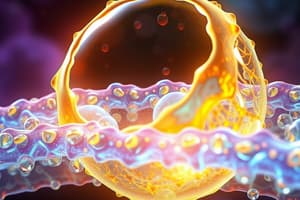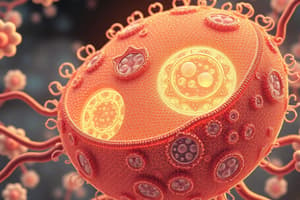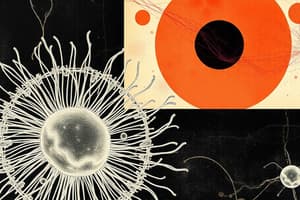Podcast
Questions and Answers
What is the focus of the study of phylogeny?
What is the focus of the study of phylogeny?
- The structure and function of plant cells.
- The evolutionary relationships among organisms. (correct)
- The interactions between organisms and their environment.
- The movement of elements through ecosystems.
What term describes all the living organisms and non-living components in a specific area?
What term describes all the living organisms and non-living components in a specific area?
- Ecosystem (correct)
- Community
- Population
- Biosphere
Which of the following describes organisms that obtain energy by consuming other organisms?
Which of the following describes organisms that obtain energy by consuming other organisms?
- Autotrophs
- Producers
- Consumers (correct)
- Decomposers
What type of tissue is responsible for transporting water and minerals from the roots to the rest of the plant?
What type of tissue is responsible for transporting water and minerals from the roots to the rest of the plant?
What is the term for a plant's growth response to light?
What is the term for a plant's growth response to light?
What is the basic unit of life?
What is the basic unit of life?
Which of the following is a key component of the plasma membrane?
Which of the following is a key component of the plasma membrane?
Where does cellular respiration primarily occur?
Where does cellular respiration primarily occur?
What is the main product of photosynthesis?
What is the main product of photosynthesis?
What is the function of DNA?
What is the function of DNA?
What is the process by which RNA is synthesized from a DNA template called?
What is the process by which RNA is synthesized from a DNA template called?
What mechanism of evolution explains organisms with advantageous traits being more likely to survive and reproduce?
What mechanism of evolution explains organisms with advantageous traits being more likely to survive and reproduce?
What is the term for the process by which new species arise?
What is the term for the process by which new species arise?
Flashcards
Phylogeny
Phylogeny
The study of evolutionary relationships between organisms.
Ecosystem
Ecosystem
Living organisms and non-living components in an area, interacting as a unit.
Xylem
Xylem
Vascular tissue that transports water and minerals in plants.
Phototropism
Phototropism
Signup and view all the flashcards
Biosphere
Biosphere
Signup and view all the flashcards
What is Biology?
What is Biology?
Signup and view all the flashcards
What is a Cell?
What is a Cell?
Signup and view all the flashcards
Where do cells come from?
Where do cells come from?
Signup and view all the flashcards
What are Prokaryotes?
What are Prokaryotes?
Signup and view all the flashcards
What is the Plasma Membrane's function?
What is the Plasma Membrane's function?
Signup and view all the flashcards
What are Genes?
What are Genes?
Signup and view all the flashcards
What is Evolution?
What is Evolution?
Signup and view all the flashcards
What is Natural Selection?
What is Natural Selection?
Signup and view all the flashcards
Study Notes
- Biology is the scientific study of life, examining the structure, function, growth, origin, evolution, and distribution of living organisms.
- It encompasses a broad range of fields, including botany, zoology, microbiology, genetics, and ecology.
Cell Biology
- The cell is considered the basic unit of life.
- Cell theory states that all living organisms are composed of one or more cells, the cell is the basic unit of structure and organization in organisms, and cells arise from pre-existing cells.
- Eukaryotic cells contain membrane-bound organelles, such as the nucleus, mitochondria, and endoplasmic reticulum; examples include animal and plant cells.
- Prokaryotic cells lack membrane-bound organelles; bacteria and archaea are prokaryotes.
- The plasma membrane is a selective barrier that regulates the passage of substances into and out of the cell.
- Key components of the plasma membrane include a phospholipid bilayer, proteins, and carbohydrates.
- Cellular respiration occurs in the mitochondria, generating ATP (adenosine triphosphate), the primary energy currency of the cell.
- Photosynthesis occurs in chloroplasts (in plants and algae), converting light energy into chemical energy in the form of glucose.
Genetics
- Genes are the units of heredity and are composed of DNA (deoxyribonucleic acid).
- DNA consists of two strands forming a double helix, with nucleotides made up of a sugar, phosphate group, and a nitrogenous base (adenine, guanine, cytosine, or thymine).
- RNA (ribonucleic acid) is involved in protein synthesis and has uracil instead of thymine.
- DNA replication is the process by which DNA makes copies of itself.
- Transcription is the process by which RNA is synthesized from a DNA template.
- Translation is the process by which proteins are synthesized using the information encoded in mRNA (messenger RNA).
- Mutations are changes in the DNA sequence and can be spontaneous or induced by mutagens.
- Mendelian genetics describes the principles of inheritance, including segregation and independent assortment.
Evolution
- Evolution is the change in the heritable characteristics of biological populations over successive generations.
- Natural selection is a mechanism of evolution where organisms with advantageous traits are more likely to survive and reproduce.
- Adaptation is the process by which organisms become better suited to their environment.
- Evidence for evolution includes the fossil record, comparative anatomy, embryology, and molecular biology.
- Speciation is the process by which new species arise, often through reproductive isolation.
- Phylogeny is the study of the evolutionary relationships among organisms.
- The tree of life illustrates the evolutionary connections between all living organisms.
Ecology
- Ecology is the study of the interactions between organisms and their environment.
- An ecosystem includes all the living organisms (biotic factors) in an area and the non-living components (abiotic factors) with which they interact.
- Populations are groups of individuals of the same species living in the same area.
- Communities are assemblages of different populations that live together in a defined area.
- The biosphere is the global sum of all ecosystems.
- Energy flow in ecosystems typically starts with the sun, which is captured by producers (autotrophs) through photosynthesis.
- Consumers (heterotrophs) obtain energy by feeding on other organisms.
- Food chains and food webs illustrate the transfer of energy and nutrients through ecosystems.
- Biogeochemical cycles (e.g., carbon, nitrogen, water) describe the movement of elements and compounds through biotic and abiotic components of ecosystems.
Plant Biology
- Plants are autotrophic eukaryotes that belong to the kingdom Plantae.
- Plant cells have chloroplasts for photosynthesis and cell walls made of cellulose.
- Vascular plants have vascular tissues (xylem and phloem) for the transport of water, minerals, and sugars.
- Xylem transports water and minerals from the roots to the rest of the plant.
- Phloem transports sugars from the leaves to other parts of the plant.
- Roots anchor the plant and absorb water and nutrients.
- Stems provide support and transport materials.
- Leaves are the main sites of photosynthesis.
- Flowers are the reproductive structures of angiosperms (flowering plants).
- Gymnosperms (e.g., conifers) reproduce via cones.
- Plant hormones (e.g., auxins, cytokinins, gibberellins) regulate plant growth and development.
- Plant responses to environmental stimuli include phototropism (growth towards light) and gravitropism (growth in response to gravity).
Studying That Suits You
Use AI to generate personalized quizzes and flashcards to suit your learning preferences.




